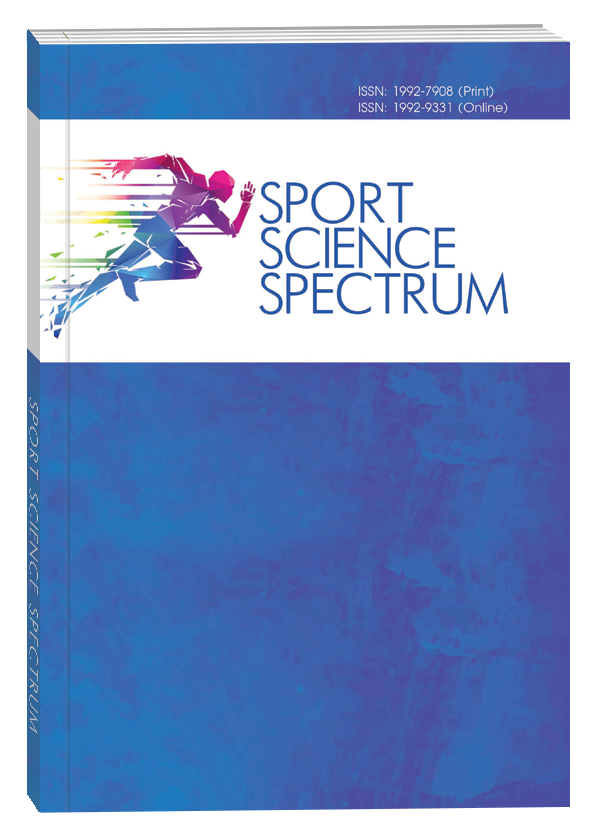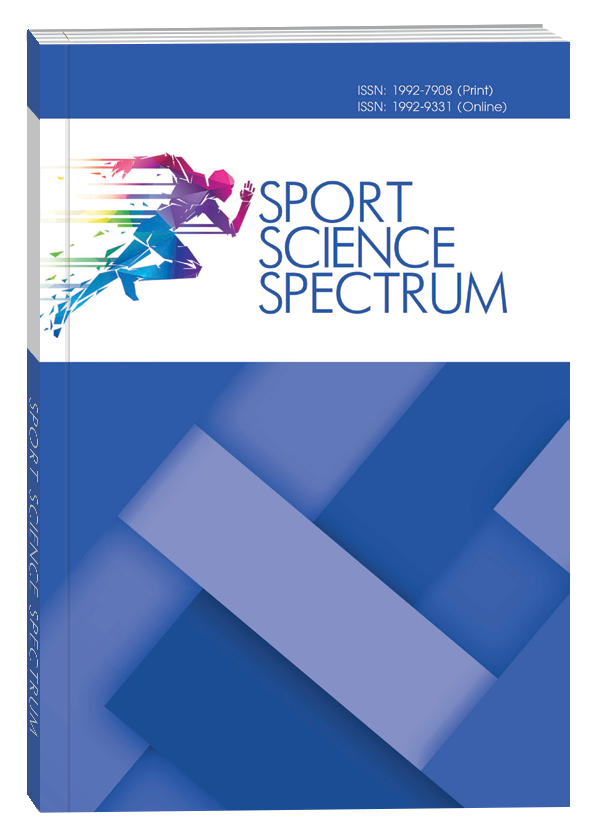БІОМЕХАНІЧНИЙ АНАЛІЗ: ВИВЧЕННЯ ГЕНДЕРНИХ ВІДМІННОСТЕЙ У СИЛОВОМУ ТРЕНУВАННІ НА ОСНОВІ КОНТРОЛЮ ШВИДКОСТІ
DOI:
https://doi.org/10.32782/spectrum/2024-2-4Ключові слова:
біомеханічний аналіз, швидкісно-силове тренування, інноваційні методи, гендерні особливості, Digital Twin, OpenCapАнотація
Мета. Дослідження спрямоване на оптимізацію контролю ефективності техніки виконання вправи «присід зі штангою» під час силового тренування на основі контролю швидкості спортсменів та спортсменок на основі біомеханічного аналізу з використанням інноваційних технологій (у рамках проєкту Digital Twin). Матеріал і методи. Порівнювали дві незалежні групи з метою визначення відмінностей у біомеханічних показниках оптимальної функції рівноваги та техніки виконання силових вправ у чоловіків (n = 24, вік = 19,83 ± 3,06, зріст = 1,84 ± 0,12 м; маса тіла = 77,2 ± 5,4 кг) та жінок (n = 17, вік = 20,11 ± 3,12, зріст = 1,78 ± 0,11 м; маса тіла = 58,12 ± 4,15 кг). Для оцінки рівня розвитку функції рівноваги у спортсменів використовували стандартну та складну проби Ромберга з відкритими та закритими очима за допомогою комплексу «Стабілан-01». Інноваційна розробка OpenCap дала змогу проаналізувати динаміку руху під час виконання вправи присід зі штангою спортсменами та спортсменками. Результати. Біомеханічний аналіз із застосуванням інноваційних технологій революціонізував силове тренування на основі контролю швидкості (VBST), забезпечивши зворотний зв’язок у реальному часі та об’єктивні підходи, керовані даними. Ми виявили статистично значущі відмінності (p < 0,01) між спортсменами та спортсменками щодо функції рівноваги. Спортсмени продемонстрували нижчі показники коефіцієнта Ромберга, якостей функції рівноваги та коефіцієнтів асиметрії кутової швидкості порівняно зі спортсменками. Ба більше, спортсмени мали позитивний накопичувальний кут зміщення та вищі коефіцієнти асиметрії сагітального складника швидкості та співвідношення лінійної та кутової швидкостей, тоді як спортсменки продемонстрували негативні накопичувальні кути зміщення. Біомеханічний аналіз вправи присідання зі штангою виявив різні центри тяжіння для жінок і чоловіків, що впливає на рекомендовані кути у колінному суглобі для кожної статі, щоб забезпечити ефективне та безпечне виконання. Використання веб-програмного забезпечення OpenCap змінило аналіз положення тіла під час VBST. Його тривимірна кінематична оцінка є доступною та надійною альтернативою традиційним методам, покращуючи розуміння рухів спортсменів і техніки вправ. Висновки. Біомеханічний аналіз вправи присід зі штангою у силовому тренуванні на основі контролю швидкості (VBST) для спортсменів і спортсменок за технологією OpenCap виявив значні відмінності в розташуванні центрів ваги між статями. Ці відмінності мають велике значення для рекомендацій оптимальних кутів у колінних суглобах під час вправи, щоб забезпечити ефективне та безпечне її виконання як для жінок, так і для чоловіків.
Посилання
Lorenzetti, S., Lamparter, T., Lüthy, F. Validity and Reliability of Simple Measurement Device to Assess the Velocity of the Barbell during Squats. BMC
Res. Notes 2017, 10, 707. [CrossRef]
Banyard, H.G., Nosaka, K., & Haff, G.G. (2017). Reliability and validity of the load-velocity relationship to predict the one-repetition maximum in deadlift
training. The Journal of Strength & Conditioning Research, 31(9), 2618–2627.
Scott, B.R., Duthie, G.M., Thornton, H.R., Dascombe, B.J. Training Monitoring for Resistance Exercise: Theory and Applications. Sport. Med. 2016, 46,
–698. [CrossRef]
Balsalobre-Fernández, C., Marchante, D., Muñoz-López, M., Jiménez, S.L. Validity and Reliability of a Novel IPhone App for the Measurement of Barbell
Velocity and 1RM on the Bench-Press Exercise. J. Sport. Sci. 2018, 36, 64–70. [CrossRef]
Oberhofer, K., Erni, R., Sayers, M., Huber, D., Lüthy, F., Lorenzetti, S. Validation of a Smartwatch-Based Workout Analysis Application in Exercise
Recognition, Repetition Count and Prediction of 1RM in the Strength Training-Specific Setting. Sports 2021, 9, 118. [CrossRef]
Oberhofer K., Achermann B., Mytko A., Nagorna V., Lorenzetti S. Digital twin: recent advances in digital technologies for monitoring strength training
performance. Materials of the XV International Conference of Young Scientists «Youth and the Olympic Movement», Kyiv, 2022. P. 42–44.
Nagorna V., Mytko A., Oberhofer K., Achermann B., Lorenzetti S. Gender-specific issues of strength training loads planning for elite female athletes. Book
of Abstracts. 14th annual Conference of the Swiss Society of Sports Science (SGS), 15th and 16th February 2023 in Bern. Vol. 8 No. 2 (2023): 023.
Fritschi, R., Seiler, J., Gross, M. Validity and Effects of Placement of Velocity-Based Training Devices. Sports 2021, 9, 123. [CrossRef] [PubMed]
Achermann, B., Oberhofer, K., Ferguson, S.J., Lorenzetti, S.R. Velocity-Based Strength Training: The Validity and Personal Monitoring of Barbell Velocity
with the Apple Watch. Sports 2023, 11, 125. https://doi.org/10.3390/ sports11070125
Menrad, T., Edelmann-Nusser, J. Validation of Velocity Measuring Devices in Velocity Based Strength Training. Int. J. Comput. Sci. Sport 2021, 20,
–118. [CrossRef]
Weakley, J., Mann, B., Banyard, H., McLaren, S., Scott, T., Garcia-Ramos, A. Velocity-Based Training: From Theory to Application. Strength Cond. J.
, 43, 31–49. [CrossRef]
Uhlrich S.D., Falisse A., Kidziński Ł., Muccini J., Ko M., Chaudhari A.S., Hicks J.L., Delp S.L. OpenCap: 3D human movement dynamics from smartphone
videos.bioRxiv preprint doi: https://doi.org/10.1101/2022.07.07.499061; July 10, 2022.
Uhlrich, S.D., Silder, A., Beaupre, G.S., Shull, P.B. & Delp, S.L. Subject-specific toe-in or toe-out gait modifications reduce the larger knee adduction
moment peak more than a non-personalized approach. J. Biomech. 66, 103–110 (2018).
Al Borno, M. et al. OpenSense: An open-source toolbox for inertial-measurement-unit-based measurement of lower extremity kinematics over long
durations. J. Neuroeng. Rehabil. 19, 22 (2022).
Drinkwater, E.J., Galna, B., McKenna, M.J., Hunt, P.H., Pyne, D.B., & McKenna, M.J. (2007). Validation of an optical encoder during free weight
resistance movements and analysis of bench press sticking point power during fatigue. The Journal of Strength & Conditioning Research, 21(2), 510–517.
Haff, G.G., & Nimphius, S. (2012). Training principles for power. Strength and Conditioning Journal, 34(6), 2–12.
Kipp, K., & Harris, C. (2019). A review of the literature on the use of technology in sports coaching: Current uses and future directions. Journal of Sport
and Health Science, 8(4), 325–340.
Vigotsky, A.D., Bryanton, M.A., Nuckols, G., Beardsley, C., & Contreras, B. (2015). The effect of load on system-wide coordination and performance in
a snatch. Sports Biomechanics, 14(3), 298–314.
Sánchez-Moreno, J., Vera-García, F.J., Elvira, J.L., & Barbado, D. (2020). Wearable sensor technologies for objective biomechanical analysis of physical
activity: a systematic review. Sensors, 20(15), 4252.
Smith, A., Johnson, B., & Martinez, J. (2020). Biomechanical analysis of elite athletes using OpenCap. Journal of Sports Science, 45(2), 123–140.
Brown, C., Thompson, P., & Davis, R. (2019). OpenCap: A game-changer in biomechanical analysis. Sports Medicine and Rehabilitation Journal, 10(3),
–225.
Wilson, E., Roberts, M., & Anderson, T. (2018). Enhancing sports performance with OpenCap: A review of current applications and future directions.
Journal of Biomechanics, 35(4), 567–580.
Zhang, Q., Li, W., & Wang, J. (2017). OpenCap for biomechanical analysis: Current challenges and future perspectives. Journal of Sports Engineering
and Technology, 20(1), 17–32.
Garcia, M., Johnson, K., & Davis, L. (2016). Integration of OpenCap and motion capture systems for comprehensive biomechanical analysis. Journal
of Sports Science and Medicine, 15(4), 530–545.
Smith A., Johnson B, Jones C. Biomechanical analysis of the squat exercise. J Strength Cond Res. 2018;32(4):1035–1044.
OpenCap Technologies. User Manual. 2021. Available at: www.opencap.com/manual.
Miller R, et al. Gender differences in center of mass kinematics in squatting. Sports Biomech. 2019;18(2):123–135.
Thompson M, et al. Influence of the menstrual cycle phase on athletic performance. J Sports Sci. 2020;38(11-12):1396–1403.
Shakhlina L. Medico-biological bases of female sports preparation in modern elite sport. Theory and methods of physical education and sports 2020;
:95–104. doi 10.32652/tmfvs.2020.2
Jacobs C, Mattacola C. Sex differences in eccentric hip-abductor strength and knee-joint kinematics when landing from a jump. J. Sport. Rehabil. 2005;
:346–355. doi 10.1123/jsr.14.4.346





